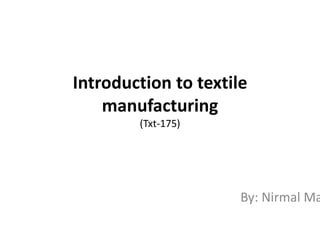
Text 175(lec 1 & lec 2) by nirmal malik
- 1. Introduction to textile manufacturing (Txt-175) By: Nirmal Ma
- 3. “A textileis a flexible woven material consisting of a network of natural or artificial fibers often referred to as thread or yarn. Yarn is produced by spinning raw fibers to produce long strands. Textiles are formed by weaving, knitting, crocheting, knotting, or pressing fibers together. Textiles are often associated with the production of clothing”
- 5. IMPORTANCE AND USES OF TEXTILES • Textile products play a vital role in meeting man’s basic needs. • We often only consider textiles to be the clothes we wear. • Textiles are also important in all aspects of our lives from birth to death. BUT HOW….?
- 6. IMPORTANCE AND USES OF TEXTILES Food Industry • Farmers wear protective clothing to spray their crops with pesticides. • Textiles are used to cover plants and wrap trees for protection from weather and insects. • Coffee filters and tea bags are made of a nonwoven textile.
- 7. IMPORTANCE AND USES OF TEXTILES Building Materials • Textiles are used in our homes to insulate them from heat and cold. • The furniture, on which we sit and sleep, is composed of various types of textile products. • Textiles are used in roofing materials, wire coverings, wall coverings, blinds, air ducts and window screens.
- 8. IMPORTANCE AND USES OF TEXTILES Transportation • Textiles used to line the beds of the roads before they are paved. • A tire gets seventy five percent of its strength from textiles. • Kevlar aramid is often used to strengthen radial tires because it is lightweight and five times stronger than steel. • The interiors of all types of transportation vehicles are covered with textiles. • Textiles are also used in the brake linings, gaskets, seals, seat belts, air bags and filters of vehicles. • The Lear Fan Jet airplane body is composed of 100 percent carbon fiber composite material. This carbon material is half the weight of aluminum and as strong as steel. • The heat shields on spacecraft are composed of a fiber that will withstand 20,000 degrees Fahrenheit.
- 9. IMPORTANCE AND USES OF TEXTILES • Health Industry Textiles are used as life saving devices in the healthcare industry. • The artificial kidney used in dialysis is made of 7,000 hollow fibers and is only two inches in diameter. • The Jarvik-7 artificial heart is composed of over fifty percent textiles and has Velcro fittings. • Artificial arteries made of knitted polyester. • The invention of disposable clothing helps prevent the spread of bacteria. • Sutures for wounds are now made of a dissolvable textile fiber. • Casts for broken bones, surgical masks, bandages and gloves are other examples of textiles used in the healthcare industry.
- 10. IMPORTANCE AND USES OF TEXTILES Protective Textiles • Bulletproof vests. • Firefighters and race-car drivers wear apparel made of Nomex aramid to protect them from the extreme heat they encounter in their professions. • Astronauts wear suits made of Nomex aramid that protect them from the elements of space. • Sports players wear protective helmets and pads made of textiles.
- 11. IMPORTANCE AND USES OF TEXTILES Recreational Products • Sports equipment such as sailboats, hockey sticks, fishing rods, golf clubs and tennis rackets are composed of textile fibers. • Backpacks, balls, life jackets and artificial playing surfaces are also made of textile fibers.
- 12. IMPORTANCE AND USES OF TEXTILES Miscellaneous Textile Products Other products composed of textiles that are not usually thought of as textile products are as follows: • Toothbrushes • Hair Brushes • Dental Floss • Artificial Flowers/Plants • Book Bindings • Candle Wicks • Communication Lines • Circuit Boards
- 15. TEXTILE FIBRE Fiber: It is defined as one of the delicate, hair portions of the tissues of a plant or animal or other substances that are very small in diameter in relation to there length. Textile Fiber: Textile fiber has some characteristics which differ between fiber to Textile fiber. Textile fiber can be spun into a yarn or made into a fabric by various methods including weaving, knitting, braiding, felting, and twisting.
- 16. PROPERTIES OF TEXTILE FIBRE Primary Properties • Length • Flexibility (Pliability) • Cohesion • Tenacity (Sufficient strength) • Uniformity • Acceptable Extensibility for the processes Secondary Properties • Absorbency • Fineness • Elasticity • Durability • Flammability • Luster
- 17. CLASSIFICATION OF TEXTILE FIBER Textile Fiber Natural Fiber Man Made Fiber
- 18. NATURAL FIBER Natural fibers include those produced by plants, animals, and geological processes. They are biodegradable over time.
- 20. MAN MADE FIBER It is also known as Manufactured fiber. Synthetic or man-made fibers generally come from synthetic materials such as petrochemicals. But some types of synthetic fibers are manufactured from natural cellulose
- 21. ADVANTAGES OF MAN MADE FIBER • Synthetic fibers do not depend either on an agricultural crop or on animal farming. • Artificially made, hence available plentifully. • They are generally cheaper than natural fiber. • Easy to wash and dry up quickly. • More stain resistant than natural fibers. • Resistant to insects, fungi and rot. • Pick-up different dyes readily. • Stronger and more durable than natural fibers.
- 22. DISADVANTAGES OF MAN MADE FIBER • Synthetic fibers burn more readily than natural fibers. • Prone to heat damage. Melt relatively easily. • Prone to damage by hot washing. • More electrostatic charge is generated by rubbing than with natural fibers. • Not skin friendly, so uncomfortable for long wearing. • Allergic to some persons. • Non-biodegradable in comparison to natural fibers.
